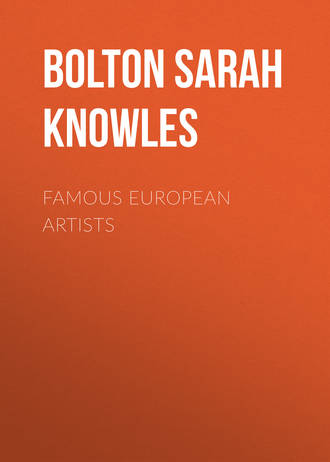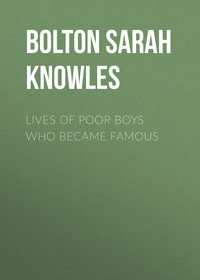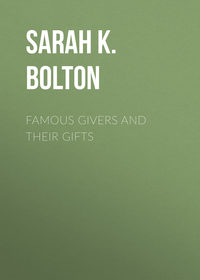 полная версия
полная версияFamous European Artists
The next year Marie Rubens returned to their old home at Antwerp, and by her good sense and persistence recovered the estates of her husband, which had been confiscated during the wars, thus placing her family in very comfortable circumstances. Peter entered a Jesuits' college, where he showed great aptitude for languages. In childhood he had been taught Latin by his father, and French by a tutor. Later, he learned Italian, Spanish, German, and English, besides, of course, speaking his native Flemish. His mother had destined him for the law, but it was distasteful to him.
At the age of thirteen, as was often the custom, the frank and handsome boy was made a page in the household of his godmother, the Countess Lalaing, but he took no pleasure in mere fashionable surroundings, and begged his mother that he might become an artist.
This choice did not attract the mother, whose ambitions and hopes centred largely in her enthusiastic Peter, but she had the wisdom to lead rather than to dictate. Parents who break the wills of their children usually have spoiled children as the result.
She placed her boy with Tobias Verhaeght, a landscape painter, from whom the lad learned that close study of nature which made him thereafter a reader of her secrets. Conrad Busken Huet says, in his "Land of Rubens": "Man and nature as the Creator made them were quite sufficient for Rubens's inspiration, no matter where he found them, far from home or close to it. What attracted him most in nature was the unchangeable, the imperishable, and the grand. He knew how to find these everywhere. Artists less gifted and born by the seashore have before now felt the want of sniffing the mountain breeze. Did their cradle stand among the meadows, they longed for running streams and rivers. Rubens's pictures prove that such contrasts had no value for him.
"Within the narrow limits of his native soil, he found every condition necessary to the practice of his art. His imagination had no need of anything more stirring than that presented to him by the recollection of human vicissitudes amidst glebe and glade. The twinkling of the eye sufficed to transform them into battlefields in his productions…
"When the sun shines, he shines everywhere. Such is Rubens's motto. He knows but one moon, but one starry vault, but one gloaming, but one morning dew. Every raindrop on which there falls a ray of light reminds him of a diamond. Each stubble-field whence uprises the lark supplies music to his ears. Each swan to which he flings bread-crumbs on his arrival at 'Steen' (his country home) teaches him to keep the most sublime song of his art for the end."
"It is curious to note that Rubens," says Charles W. Kett, in his "Life of Rubens," "who began with scenes of country life, returned in his last days to his first love, so that when he could no longer cover his huge canvases with heroic figures, he would retire to his château at Steen, and paint landscapes, even though the gout almost incapacitated him from holding his brushes."
After about ten years spent with Verhaeght, young Rubens, thinking that he would devote himself to historical subjects, became a pupil of Adam van Noort, a teacher skilled in drawing, and in the use of brilliant color, with study of light and shade. He is said to have been intemperate and quick-tempered, but for four years Rubens found him a useful teacher.
"It is related," says George H. Calvert, "that one day, when the master was absent, the pupil took a fresh canvas to try what he could do by himself towards representing a weeping Madonna. He worked for hours, and so intently that he did not hear the returning footsteps of the master, who from behind gazed in admiration and wonder at his performance."
The young painter was restless, not an unnatural condition for an ardent, ambitious boy or girl. Such a life, fruitful for good or evil, must be filled with the best activities.
When Rubens was nineteen, he entered the studio of Otto Venius, a kind and learned man, of courtly manners, a free-master of the Guild of St. Luke, and court painter to Archduke Albert of Austria and the Infanta Isabella of Spain. She was the daughter of Philip II., to whom he had ceded the "Spanish Netherlands." They were distinguished patrons of art, and did everything to restore the war-worn country to peace and prosperity. Venius became deeply attached to his pupil, made him acquainted with the Regents Albert and Isabella, and inspired him to go to Italy to study art, the country in which he had studied for seven years.
Rubens had already painted some admirable works: the "Adoration of the Three Kings," a "Holy Trinity," a "Dead Christ in the Arms of the Father," and a portrait of Marie Pypelincx, "the true-hearted wife," says Mr. Kett, "of the faithless Jans, the mother of the artist, the upholder of the family after the death of the father, the educator of his children, and the restorer of the fallen greatness of the name of Rubens. Calmly and beautifully does the pale face still look forth from the canvas as of old. She must have smiled with satisfaction on the rising fame of her youngest surviving son, now going forth into the world to have those talents acknowledged which her maternal heart was assured were in his keeping. Carefully attired, like a matron of good family, in velvet dress, mourning coif, and muslin cuffs, denoting her widowed state, she carries in her face the traits of a shrewd woman of the world, who has battled bravely with the times, and now sees victory crowning her endeavors.
"Her very chair, somewhat similar to the one still preserved in the Academy at Antwerp as the gift of her son, speaks of a home of comfort; her book, held in her still handsome hand, a forefinger marking the page she has not finished reading, tells of a certain amount of learned leisure; and her whole surroundings recall a home whence an artist, a man of culture, and a courteous gentleman might derive those early impressions and first inspirations which would develop, when he came in contact with a larger world, into masterpieces of art."
On May 8, 1600, Rubens, at twenty-three years of age, having said good-by to his fond mother, started for Italy. His first visit was to Venice, where he studied the wonderful colorists, Titian, Paul Veronese, and Tintoretto. He is said to have copied twenty portraits by Titian, so earnest was he in obtaining the secret of these marvellous tints.
While here he became the friend of a Mantuan, an officer at the court of Vincenzo de Gonzaga, Duke of Mantua. This duke was thirty-seven years old, rich, handsome, somewhat of a poet, the patron of artists and authors, a brilliant and extravagant ruler. Through this friend, and also by letters of introduction from Archduke Albert, Rubens met Gonzaga, who was surprised at the learning of the attractive and distinguished-appearing young artist. Hearing him repeat a passage from Virgil, Gonzaga addressed him in Latin, and was answered in the same language, fluently and correctly. The duke had made a fine collection of paintings and antiques, and these Rubens was glad to study. A most fortunate thing resulted from this acquaintance; Rubens was appointed painter to the court and a member of the ducal household.
This was not the result merely of fortuitous circumstances. Rubens had been a student. He was called later by scholars, "the antiquary and Apelles of our time." He was also a most industrious worker. Philip Rubens, his nephew, says in his life of his uncle, "He never gave himself the pastime of going to parties where there was drinking and card-playing, having always had a dislike for such." So fond was he of reading the best books, that in after years, when he painted, Seneca and Plutarch were often read to him. He had studied the technique of painting since he was thirteen years old. He was especially charming in manner, being free from harshness or censoriousness, and, withal, a person of much tact and consideration. He had prepared himself for a great work, and was ready to embrace his opportunity when it came.
Besides painting several originals for the Duke of Mantua, Rubens was sent to Rome to make copies of some of the masterpieces. He took letters of introduction to Cardinal Alessandro Montalto, the nephew of Sixtus V., very rich, and a great patron of art.
Besides this work for Gonzaga, Rubens painted for the chapel of St. Helena, in the Church of the Holy Cross of Jerusalem, at Rome, at the request of Archduke Albert, formerly its cardinal, three pictures: "St. Helena embracing the Cross," "Christ crowned with Thorns," and a "Crucifixion."
On his return to Mantua, he copied the "Triumph of Julius Cæsar," by Andrea Mantegna; in one of the series, in place of a sheep walking by the side of an elephant, he painted a lion. Dr. Waagen says in his "Life of Rubens": "His love of the fantastic and pompous led him to choose that with the elephant carrying the candelabra, but his ardent imagination, ever directed to the dramatic, could not be content with this; instead of a harmless sheep, which in Mantegna is walking by the side of the foremost elephant, Rubens has introduced a lion and lioness, which growl angrily at the elephant. The latter, on his part, is not idle, but, looking furiously round, is on the point of striking the lion a blow with his trunk. The severe pattern he had before him in Mantegna has moderated Rubens in his taste for very full forms, so that they are here more noble and slender than is usual with him. The coloring, as in his earliest pictures, is more subdued than in the later, and yet more powerful. Rubens himself seems to have set a high value upon this study, for it was among his effects at his death."
In 1603, Rubens was sent by the Duke of Mantua on a pleasant mission to Spain, with costly presents to Philip III., the indolent son of Philip II., and his powerful favorite, the Duke of Lerma. For the king there was a "gorgeous coach and seven beautiful horses, twelve arquebuses, six of whalebone and six variegated, and a vase of rock crystal filled with perfumes." For the Duke of Lerma, "a number of pictures, a silver vase of large dimensions inwrought with colors, and two vases of gold. For the Countess of Lerma, a cross and two candelabra of rich crystal. For the secretary, Pedro Franqueza, two vases of rock crystal, and a complete set of damask hangings, the edges of gold tissue."
After a long journey, with continuous rain for twenty-five days, Rubens and his gifts reached Valladolid. When the paintings were unpacked, they were nearly ruined, from the colors having peeled off. At the request of Iberti, resident at the Court of Madrid from Mantua, Rubens undertook the work of restoration, and, better still, painted two originals for the Duke of Lerma, a "Democritus," and a "Heraclitus," both life-size, now in the gallery of Madrid. He also painted an equestrian likeness of the duke himself, several ladies of the court, for the gallery of beauties possessed by Gonzaga, and probably many other pictures on this first visit, as more than one hundred and twenty of Rubens's paintings are known to have existed in Spain. On his return to Italy he was loaded with gifts from the King of Spain and grandees, so much were his works esteemed and so greatly was the young Fleming admired. Once more in Italy, Rubens painted an altar-piece for the Church of the Holy Trinity at Mantua, in which the mother of the duke was buried; three pictures, the "Baptism of our Saviour," the "Mystery of the Transfiguration," and a central picture, the "Mystery of the Trinity," which latter contained portraits of Duke Vincenzo, his Duchess Leonora, his parents, and his children. When the French took Mantua in 1797, this church was used as a storehouse for food for the horses. A French commissary cut this picture in pieces, the better to carry it, and, when about to send it to France, was prevented by the Academy of Mantua. Some of the pieces have disappeared.
Rubens also painted, for the Church of Santa Maria in Valicella, Rome, an altar-piece, representing the "Madonna and Child," with side pictures of the pope and several saints. In co-operation with his brother Philip, he published, in 1608, a book on Roman antiquities, with six copper-plate illustrations. The pope was so pleased with Rubens that he desired to keep him in Rome permanently.
For the Grand Duke Ferdinand I. of Florence, Rubens painted several pictures, among them a "Hercules between Venus and Minerva." In Spain he executed a series called "The Labors of Hercules," besides three separate ones, representing the slaying of the dragon, the struggle with Antæus, and the combat with a lion. He also copied the celebrated cartoon of Leonardo da Vinci, called "The Battle of the Standard," and made a valuable portrait of himself for the Grand Ducal collection of self-painted heads of artists. At Genoa he made drawings of her remarkable palaces and churches, which he published later in a volume with one hundred and thirty-nine illustrations.
After an absence of eight years in Italy, Rubens was recalled to Antwerp by the illness of his mother. He started homeward October 28, 1608, with a heavy heart. On his way he learned that she had died nine days before he began his long journey.
On reaching Antwerp, he shut himself up for four months in the Abbey of St. Michael's, where she had been buried. He had given her no ordinary affection, and his was no ordinary loss. He met this loss in the silence of his own thoughts in the abbey, and when he had gained the self-control necessary for his work, he came out into the world. Most of us learn to bear our sorrows in our own hearts, without laying our burdens upon others, finding, sooner or later, that the world has enough of its own.
He talked of returning to Italy, but Archduke Albert and Isabella, proud of his genius and his attainments, invited him to court, sat for their portraits, and made him their official painter. One of his first works for them was a "Holy Family," which was so much admired that the Society of St. Ildefonso of Brussels, Archduke Albert being its head, ordered an altar-piece for the Chapel of the order of St. James. "This picture," says Dr. Waagen, "which is at present in the Imperial gallery at Vienna, represents the Virgin Mary enthroned, and putting the cloak of the order on the shoulders of St. Ildefonso. She is surrounded by four female saints. On the interior of the wings are the portraits of Albert and Isabella, with their patron saints. This work, one of the most admirable ever painted by Rubens, displays in a remarkable degree the qualities praised in the one painted for the Archduke."
The association were so pleased that they offered the artist a purse of gold, which, having been made a member, he would not receive, saying that his only desire was to be useful to his brother members.
Lonely from the death of his mother, a new affection came into his heart to sustain and console him. Philip, his brother, now secretary of Antwerp, had taken as his wife Maria de Moy, whose sister, Clara, much older, had married a former secretary of Antwerp, Jan Brandt. Their daughter, Isabella Brandt, was a young woman of attractive face and sweet disposition. Peter naturally met the niece of his brother Philip's wife, loved her, and married her October 13, 1609, in the Abbey Church of St. Michael, when he was thirty-two.
He soon built a house, costing sixty thousand florins, in the Italian style of architecture, with a spacious studio, and a separate building or rotunda, like the Pantheon at Rome, lighted from the top, where he arranged the pictures, marbles, vases, and gems which he had collected in Italy. Adjoining this he laid out a large garden, planted with flowers and choice trees.
"The celebrated picture of Rubens and his first wife," says Mr. Kett, "now in the Pinakothek at Munich, must have been painted within the first few years of their married life, and is a striking example of the painter's manner at this period. His calm serenity and thoughtful expression, combined with beauty and force of character, are well balanced by the placid contentment and happy dignity of his wife, as the pair sit under their own vine and fig-tree, prepared to receive their visitors. There is no affected demonstration of feeling, no bashful restraint. A couple well-to-do and able to enjoy themselves are happy to share their pleasure with others."
In 1611, Rubens met with a severe loss in the death of his greatly beloved brother, Philip. All the seven children of Jans Rubens and Maria Pypelincx were now dead save Peter Paul.
In 1614, Rubens's heart was made glad by the birth of a son, to whom Archduke Albert became godfather, and gave him his own name. Four years later his only other child by Isabella Brandt was born, both of whom survived their father. A beautiful painting of these two children is now in the Liechtenstein Gallery, in Vienna.
The rich and famous painter was now happy, surrounded by his loved ones, busy constantly with his work, which poured in upon him. In summer he rose at four o'clock, heard mass, and went to work early. Says Dr. Waagen, "This was the time when he generally received his visitors, with whom he entered willingly into conversation on a variety of topics, in the most animated and agreeable manner. An hour before dinner he always devoted to recreation, which consisted either in allowing his thoughts to dwell as they listed on subjects connected with science or politics, which latter interested him deeply, or in contemplating his treasures of art. From anxiety not to impair the brilliant play of his fancy, he indulged but sparingly in the pleasures of the table, and drank but little wine. After working again till the evening, he usually, if not prevented by business, mounted a spirited Andalusian horse, and rode for an hour or two.
"This was his favorite exercise; he was extremely fond of horses, and his stables generally contained some of remarkable beauty. On his return home, it was his custom to receive a few friends, principally men of learning or artists, with whom he shared his frugal meal, and afterwards passed the evening in instructive and cheerful conversation. This active and regular mode of life could alone have enabled Rubens to satisfy all the demands that were made upon him as an artist, and the astonishing number of works that he completed, the genuineness of which is beyond all doubt, can only be accounted for by this union of extraordinary diligence with his unusually fertile powers of production."
In building his home, Rubens encroached a little on land owned by the Company of Arquebusiers of Antwerp. A lawsuit was threatened, but finally a compromise was effected whereby Rubens agreed to paint a triptych, that is, a picture in three parts, of their patron St. Christopher, to be hung in the cathedral. In fulfilment of this contract, he painted the renowned "Descent from the Cross," now in the south end of the transept of the cathedral, with St. Simon on one wing of the triptych, and "The Visitation" on the other, with St. Christopher in person.
Says Huet: "Playing upon the name of a patron saint, he has represented a threefold 'bearing of Christ'; Christ borne from the Cross in the centre; Christ borne by old Simon on the right; Christ borne ''neath his mother's heart' on the left wing… There is no need to insist as to how Rubens acquitted himself of his task in the centre piece. Da Vinci's 'Last Supper' and Rubens's 'Descent from the Cross' are the two most popular altarpieces of Christianity, admired alike by Protestant and Catholic. For the history of Flemish art this 'Descent' possesses as much value as does Goethe's 'Faust' for the history of German literature. No one has succeeded in painting subsequent to Rubens a 'Descent from the Cross' without paying toll to the master… It is the triumph of human sympathy expressed in accordance with the theory of line and color. The painter had no other aim than to limn a perfect group of loving people, occupied in taking down the body of Christ. He does not portray your sorrow, but theirs. What he tenders us is sentiment, not sentimentality; emotion, not intellect. The allusion to St. Christopher must be disinterred from encyclopædias; the recollection of John in his red cloak, carrying his burden, of the fair-haired Mary Magdalen, of the disciple with the winding-sheet betwixt his teeth, has become immortal.
"The lovely mother-virgin of the left-hand side leaf deserves particular attention… I know of no more fascinating female figure from Rubens's brush; none which in its Flemish guise is so original, so wholly his. The 'Descent from the Cross' itself one might still believe to be the work of one of the great Italians. No such mistake is possible with the side leaf. What excites our wonder in Goethe is his succeeding in raising a Leipzig girl of the lower classes to the rank of a tragic heroine, the very mention of whose name suffices to remind us of an imperishable type. Rubens's pregnant Mary is an honorable Gretchen. He created her out of the most hidden depths of human nature, where blood and soul, mind and matter, melt into one. When Jordaens wishes to paint fertility, he resorts to the allegory of the schools. To Rubens life itself is the best of all allegories. Mary's clinging for support to the railing of the staircase, as she ascends it, is a hymn in honor of maternity. In the course of ages pictorial art has produced many beautiful works, none more beautiful than that scene."
About this time Rubens painted some of his greatest works. "Our Saviour giving the Keys to St. Peter" was originally placed in the Cathedral of St. Gudule; it was sold in 1824 to the Prince of Orange, for one hundred and twenty-five thousand dollars. An "Elevation of the Cross," an immense picture, executed for the Church of St. Walburg, at Antwerp, is now in the north transept of the cathedral. He painted an "Adoration of the Magi" for the choir of the Abbey Church of St. Michael, dear to him from the burial of his mother and his own marriage, and a similar picture for the Church of St. John at Malines.
Of an "Adoration of the Magi" in the Museum at Antwerp, Eugène Fromentin says: "It is truly a tour de force, especially if one recalls the rapidity of this work of improvisation. Not a gap, not a strain; a vast, clear half-tint and lights without excess envelop all the figures, supporting one the other; all the colors are visible and multiply values the most rare, the least sought and yet the most fit, the most subtle and yet the most distinct. By the side of types that are very ugly swarm superior types. With his square face, his thick lips, his reddish skin, big eyes strongly lighted up, and his stout body girt in green pelisse with sleeves of peacock blue, this African among the Magi is a figure entirely new, before which, assuredly, Tintoretto, Titian, Veronese would have clapped their hands.
"On the left stand in dignified solemnity two colossal cavaliers of a singular Anglo-Flemish style, the most extraordinary piece of color in the picture, with its dull harmony of black, greenish blue, of brown and white. Add the profile of the Nubian camel-drivers, the supernumeraries, men in helmets, negroes, the whole in the most ample, the most transparent, the most natural of atmospheres. Spider-webs float in the framework, and quite low down the head of the ox, – a sketch achieved by a few strokes of the brush in bitumen, – without more importance and not otherwise executed than would be a hasty signature. The Child is delicious; to be cited as one of the most beautiful among the purely picturesque compositions of Rubens, the last word of his knowledge as to color, of his skill as to technique, when his sight was clear and instantaneous, his hand rapid and careful, and when he was not too exacting, the triumph of rapture and science – in a word, of self-confidence."
Rubens had courage. He used to say: "Every one according to his gift; my talent is such that never yet has an undertaking, however extraordinary in size or diversity of subjects, daunted my courage."
The "Assumption of the Virgin" in the Antwerp Cathedral, Dr. Waagen says, "may be said to produce the same effect as a symphony, in which the united sounds of all the instruments blend together joyously, divinely, mightily. No other painter has ever known how to produce such a full and satisfactory tone of light, such a deep chiaro-oscuro united with such general brilliancy."
"St. Theresa pleading for the Souls in Purgatory," "St. Anne instructing the Virgin," and the "Dead Saviour laid on a Stone," are now at Antwerp. Five of the above pictures and three others, "Christ on the Cross," "The Resurrection of our Saviour," and "The Adoration of the Shepherds," were painted in eighteen days, Rubens receiving as compensation fifty dollars per day, his usual price.






